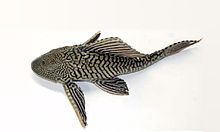Pterygoplichthyini is a tribe of catfishes (order Siluriformes) of the family Loricariidae. It includes two genera, Pterygoplichthys and the currently undescribed genus referred to as the Hemiancistrus annectens group,[1] This group was earlier misspelled as Pterygoplichthini.[1] Pterygoplichthyines are known from nearly the entire range of loricariids except for the Guyanas and coastal streams in southeastern Brazil.[1] although later work by the same authority, and his co-authors, placed this group among the genus Hypostomus.[2]
| Pterygoplichthyini | |
|---|---|

| |
| Pterygoplichthys sp. | |
| Scientific classification | |
| Domain: | Eukaryota |
| Kingdom: | Animalia |
| Phylum: | Chordata |
| Class: | Actinopterygii |
| Order: | Siluriformes |
| Family: | Loricariidae |
| Subfamily: | Hypostominae |
| Tribe: | Pterygoplichthyini Armbruster, 2004 |
| Genera | |
Pterygoplichthyini is sister to the tribe Ancistrini, which shares the derived presence of an evertible patch of plates on the cheek.[1]
Pterygoplichthys and the H. annectens group differ most obviously in the number of dorsal fin rays (7 in the H. annectens group and 9+ in Pterygoplichthys).[1] The two genera are supported as sisters by only one derived characteristic: a modified stomach that is attached to the abdominal wall by a net of connective tissue.[1]
This modified stomach allows these fish to breathe air. The stomach is vascularized. A white net of connective tissue surrounds the organ, leaving a circular area in the middle of the stomach free; this connective tissue firmly holds the stomach to the body wall and is better developed in adults. It may also function as a hydrostatic organ, allowing the fish to remain buoyant midwater.[3]
References edit
- ^ a b c d e f Armbruster, Jonathan W. "Pterygoplichthyini Armbruster 2004". Retrieved 2007-08-08.
- ^ Jonathan W. Armbruster; David C. Werneke; Milton Tan (2015). "Three new species of saddled loricariid catfishes, and a review of Hemiancistrus, Peckoltia, and allied genera (Siluriformes) (abstract)". ZooKeys (480): 97–123. doi:10.3897/zookeys.480.6540. PMC 4319111. PMID 25685026.
- ^ Armbruster, Jonathan W. (1998). "Modifications of the Digestive Tract for Holding Air in Loricariid and Scoloplacid Catfishes" (PDF). Copeia. 1998 (3): 663–675. doi:10.2307/1447796. JSTOR 1447796.